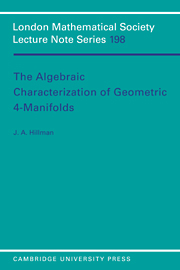Book contents
- Frontmatter
- Contents
- Preface
- I Algebraic Preliminaries
- II General results on the homotopy type of 4-manifolds
- III Mapping tori and circle bundles
- IV Surface bundles
- V Simple homotopy type, s-cobordism and homeomorphism
- VI Aspherical geometries
- VII Manifolds covered by S2 × R2
- VIII Manifolds covered by S3 × R
- IX Geometries with compact models
- X Applications to 2-knots and complex surfaces
- Appendix: 3-dimensional Poincaré duality complexes
- Problems
- References
- Index
Appendix: 3-dimensional Poincaré duality complexes
Published online by Cambridge University Press: 16 September 2009
- Frontmatter
- Contents
- Preface
- I Algebraic Preliminaries
- II General results on the homotopy type of 4-manifolds
- III Mapping tori and circle bundles
- IV Surface bundles
- V Simple homotopy type, s-cobordism and homeomorphism
- VI Aspherical geometries
- VII Manifolds covered by S2 × R2
- VIII Manifolds covered by S3 × R
- IX Geometries with compact models
- X Applications to 2-knots and complex surfaces
- Appendix: 3-dimensional Poincaré duality complexes
- Problems
- References
- Index
Summary
The main reason for studying PD-complexes is that they represent the homotopy theory of manifolds. However they also arise in situations where the geometry does not immediately provide a corresponding manifold. For instance, under suitable finiteness assumptions an infinite cyclic covering space of a closed 4-manifold with Euler characteristic 0 will be a PD3-complex, as we saw in Chapter III. (In other dimensions we could appeal to the Farrell or Stallings fibration theorems at this point). In this appendix we shall summarize briefly what is known about the homotopy types of PD3-complexes.
In lower dimensions the classification is complete. It is easy to see that the circle is the only PD1-complex. The 2-dimensional case is already quite difficult, but has been settled by Eckmann, Linnell and Müller, who showed that every PD2-group is a surface group and hence that every PD2-complex is homotopy equivalent to a closed surface [EM80, EL81]. (See also Chapter VI of [DD]). In particular, the only PD2-complexes which fibre properly are the torus and Klein bottle.
There are PD3-complexes with finite fundamental group which are not homotopy equivalent to any closed 3-manifold. However it is not known whether every PD3-complex with torsion free fundamental group is homotopy equivalent to a closed 3-manifold.
- Type
- Chapter
- Information
- The Algebraic Characterization of Geometric 4-Manifolds , pp. 152 - 157Publisher: Cambridge University PressPrint publication year: 1994

